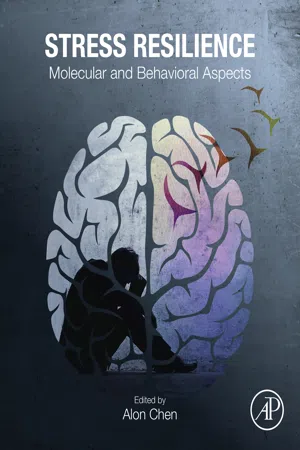
- 390 pages
- English
- ePUB (mobile friendly)
- Available on iOS & Android
About this book
Stress Resilience: Molecular and Behavioral Aspects presents the first reference available on the full-breadth of cutting-edge research being carried out in this field. It includes a wide range of basic molecular knowledge on the potential associations between resilience phenomenon and biochemical balance, but also focuses on the molecular and cellular mechanisms underlying stress resilience. World-renowned experts provide chapters that cover everything from the neural circuits of resilience, the effects of early-life adversity, and the transgenerational inheritance of resilience.This unique and timely book will be a go-to resource for neuroscientists and biological psychiatrists who want to improve their understanding of the consequences of stress and on how some people are able to avoid it.- Approaches resilience as a process rather than as a static trait- Provides basic molecular knowledge on the potential associations between resilience phenomenon and biochemical balance- Presents thorough coverage of both the genetic and environmental factors that contribute to resilience
Frequently asked questions
- Essential is ideal for learners and professionals who enjoy exploring a wide range of subjects. Access the Essential Library with 800,000+ trusted titles and best-sellers across business, personal growth, and the humanities. Includes unlimited reading time and Standard Read Aloud voice.
- Complete: Perfect for advanced learners and researchers needing full, unrestricted access. Unlock 1.4M+ books across hundreds of subjects, including academic and specialized titles. The Complete Plan also includes advanced features like Premium Read Aloud and Research Assistant.
Please note we cannot support devices running on iOS 13 and Android 7 or earlier. Learn more about using the app.
Information
A life-course, epigenetic perspective on resilience in brain and body
Abstract
Keywords
Introduction
What is stress?
Definition of stress, allostasis, and allostatic load

Modified from McEwen, B.S. 1998. Protective and damaging effects of stress mediators. The New England Journal of Medicine 338, 171–179, with permission.
Protection and damage as the two sides of the response to experiences
Table of contents
- Cover image
- Title page
- Table of Contents
- Copyright
- Dedication
- Contributors
- About the editor
- Preface
- Acknowledgments
- Chapter 1. A life-course, epigenetic perspective on resilience in brain and body
- Chapter 2. Cognitive and behavioral components of resilience to stress
- Chapter 3. Resilience as a process instead of a trait
- Chapter 4. The brain mineralocorticoid receptor: a resilience factor for psychopathology?
- Chapter 5. GABAB receptors, depression, and stress resilience: a tale of two isoforms
- Chapter 6. Sex differences in the programming of stress resilience
- Chapter 7. Active resilience in response to traumatic stress
- Chapter 8. Rhythms of stress resilience
- Chapter 9. Mitochondrial function and stress resilience
- Chapter 10. Understanding resilience: biological approaches in at-risk populations
- Chapter 11. Stress resilience as a consequence of early-life adversity
- Chapter 12. Mechanisms by which early-life experiences promote enduring stress resilience or vulnerability
- Chapter 13. Child abuse and neglect: stress responsivity and resilience
- Chapter 14. How genes and environment interact to shape risk and resilience to stress-related psychiatric disorders
- Chapter 15. Molecular characterization of the resilient brain: transcriptional and epigenetic mechanisms
- Chapter 16. The role of the CRF-urocortin system in stress resilience
- Chapter 17. Intergenerational transmission of stress vulnerability and resilience
- Chapter 18. Stress and its effects across generations
- Chapter 19. Corticolimbic stress regulatory circuits, hypothalamo–pituitary–adrenocortical adaptation, and resilience
- Chapter 20. Biomarkers of resilience and susceptibility in rodent models of stress
- Chapter 21. Maladaptive learning and the amygdala—prefrontal circuit
- Chapter 22. Endocannabinoid signaling and stress resilience
- Index